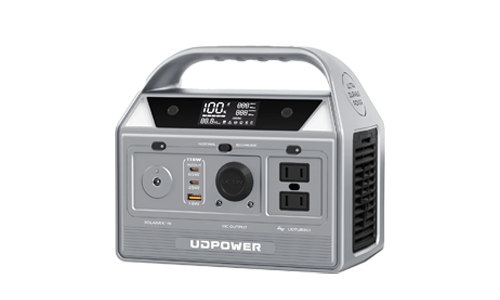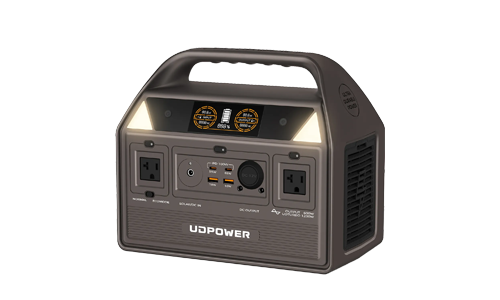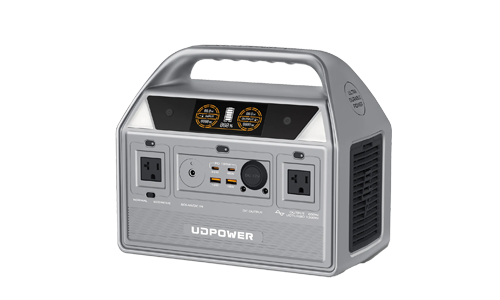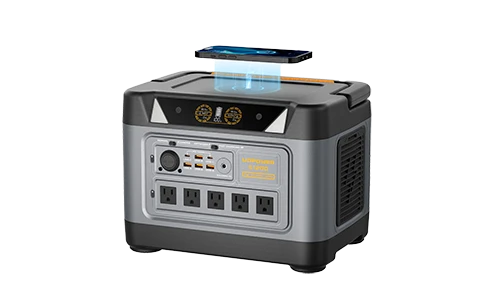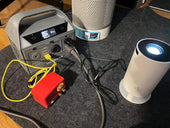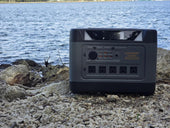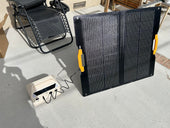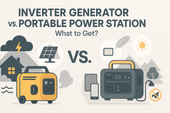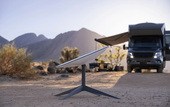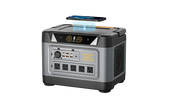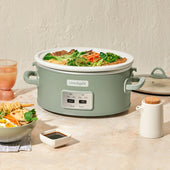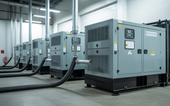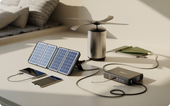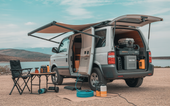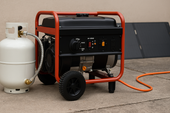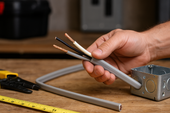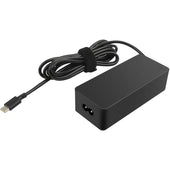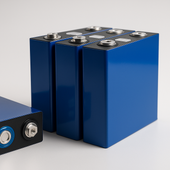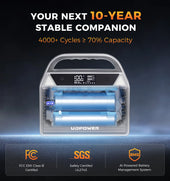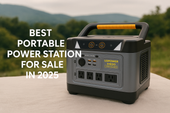How Much Is Solar Power for Home, Mobile Home, RV, and Trailer?
ZacharyWilliamIf you live in the U.S., you’re probably seeing more rooftop solar panels, more RVs with folding solar blankets, and a lot more talk about energy independence. But when you actually run the numbers, the big question is simple: “How much will solar power really cost for my situation?”
This guide walks through realistic price ranges for four common scenarios: traditional homes, mobile homes, RVs, and travel trailers. We’ll also show where a portable power station + solar panel setup from brands like UDPOWER can be a faster, lower-commitment way to get started—especially for RV and trailer owners—while keeping the recommendations low-key and practical.

What Actually Drives the Cost of Solar Power?
Whether you’re installing a full rooftop system or adding a couple of portable panels to an RV, solar isn’t one fixed price. It’s a stack of components and services. Broadly, your total cost depends on:
- How much energy you use (kWh per day/month). A small RV weekend setup is very different from a 2,000 sq ft home with air conditioning.
- System size in kW or Watts. Bigger systems with more panels and larger inverters cost more, but usually deliver a lower cost per watt.
- Grid-tied vs. off-grid. Off-grid RVs and trailers need batteries + inverters, which add a lot to the price.
- Batteries and backup power. Whole-home battery storage (for outages or time-of-use savings) can be a multi-thousand-dollar add-on.
- Hardware quality and brand. High-efficiency panels, LiFePO₄ batteries, and name-brand inverters cost more up front but usually last longer.
- Labor, permitting, and interconnection. For rooftop home or mobile-home systems, these soft costs can be 40–60% of the total.
- Incentives and tax credits. In the U.S., many home and mobile-home systems qualify for a federal 30% Residential Clean Energy Credit, plus state and utility incentives in some areas.
With those levers in mind, let’s look at realistic price ranges for each type of home or vehicle.

How Much Is Solar Power for a Typical U.S. Home?
For a conventional single-family home, the main cost driver is system size. Many U.S. homes end up with a 6–10 kW rooftop array, depending on how much air conditioning, electric heating, EV charging, or electric cooking they use.
Home Solar Cost by System Size (Grid-Tied, Before Tax Credits)
| System Size | Typical Use Case | Approx. Installed Cost | After 30% Federal Credit* |
|---|---|---|---|
| 4 kW | Very efficient / smaller homes | ~$14,000–$17,000 | ~$9,800–$11,900 |
| 6 kW | Average home with good efficiency | ~$18,000–$22,000 | ~$12,600–$15,400 |
| 8 kW | Higher usage, more AC or EV charging | ~$22,000–$28,000 | ~$15,400–$19,600 |
| 10 kW+ | Large homes, heavy electricity usage | $25,000–$35,000+ | $17,500–$24,500+ |
*If you qualify for the full 30% Residential Clean Energy Credit and current rules remain in place. Always confirm with a tax professional.
Nationwide data in 2025 puts the average home solar system roughly in the $25,000–$45,000 range before incentives, depending on size and whether battery storage is included. A straightforward grid-tied array without batteries tends to be on the lower side of that range, while adding a whole-home battery (or multiple batteries) pushes costs higher.
The upside: once installed, many homeowners see payback in roughly 6–10 years through lower utility bills, depending on local electricity prices and net-metering rules. After that, most of your solar electricity is effectively “free,” apart from routine maintenance.

How Much Is Solar Power for a Mobile or Manufactured Home?
Mobile and manufactured homes can absolutely use solar, but they bring a few quirks:
- Roofs are often smaller and lighter, so there’s less room and sometimes stricter structural limits.
- Some parks and HOAs have rules about rooftop panels; ground mounts or carport structures may be better options.
- Daily electricity use is often lower than in a large single-family house, which means a smaller system (1–5 kW) may cover a big share of your load.
Example Solar Cost Ranges for Mobile Homes
| System Size | Typical Scenario | Estimated Cost (Before Credit) | Approx. After 30% Credit* |
|---|---|---|---|
| 1 kW | Tiny/mobile home, very light usage | $2,500–$3,500 | $1,750–$2,450 |
| 2 kW | Small mobile home, efficient appliances | $5,000–$7,000 | $3,500–$4,900 |
| 3 kW | Moderate usage (TV, fridge, electronics) | $9,000–$10,500 | $6,300–$7,350 |
| 4 kW | Heavier loads, some AC | $12,000–$14,000 | $8,400–$9,800 |
| 5 kW | Larger manufactured home, higher usage | $14,000–$16,000 | $9,800–$11,200 |
*Assumes you own the home, it qualifies as your primary U.S. residence, and you’re eligible for the full federal credit. Always confirm with a tax advisor and your installer.
A typical mobile home might use around 4,000–4,500 Wh per day with efficient appliances, which roughly translates to about 15 × 300 W panels under good sun conditions if you wanted to cover most of that usage with solar. In real life, many owners combine rooftop solar with energy-efficiency upgrades and sometimes a small battery to ride through short outages.
If your roof can’t handle many panels, consider:
- Ground-mounted panels on a sunny corner of your lot.
- A carport or awning structure with integrated solar.
- A portable solar generator (battery + panels) to cover essentials like lighting, phone/laptop charging, and a compact fridge during outages.

How Much Does Solar Cost for an RV?
RV solar is a different animal from rooftop home solar. Instead of offsetting your utility bill, you’re usually trying to power:
- Lights, fans, water pump, and basic DC systems
- Phones, laptops, cameras, and small appliances
- Sometimes a residential fridge or short bursts of air conditioning
Typical RV Solar Packages & Budgets
| System Type | What It Includes | Ballpark Cost | Best For |
|---|---|---|---|
| Starter DC system | ~190–200 W panel, 100–200 Ah battery, charge controller | ~$1,500+ | Weekend trips, lights, fans, pump, USB devices |
| Mid-level AC/DC system | ~400 W solar, 200–300 Ah battery, 700–2,000 W inverter | ~$2,000–$5,000 | Longer trips, laptops, coffee maker, small microwave, TV |
| Large full-time system | 600–800 W+ solar, 400–600 Ah LiFePO₄ battery bank, robust inverter/charger | $5,000–$10,000+ | Full-timers powering residential fridge, induction cooking, more AC time |
These ranges include panels, wiring, charge controller, batteries, and inverters but not always labor. Professional installation, custom wiring, and roof work can add significantly to the total.
The big takeaway: you don’t need a massive system just to keep lights on and batteries charged. Many RVers happily camp with 200–400 W of solar and a modest LiFePO₄ battery, especially if they’re okay running a generator for heavy loads like air conditioning.

Solar Cost for Travel Trailers and Toy Haulers
Travel trailers, fifth wheels, and toy haulers often share similar electrical needs with motorized RVs. The main differences are roof layout and where you can store batteries and inverters.
In practice, solar budgets look similar to RVs:
- Lightweight setups (200–300 W solar + 100–200 Ah battery) often fall in the $1,500–$3,000 range depending on hardware quality and labor.
- Mid-range builds (400–600 W solar + larger battery + inverter) typically run $3,000–$7,000.
- High-end off-grid rigs with 800–1,000+ W solar and big LiFePO₄ banks can land between $7,000–$12,000+.
Because trailers already involve towing and weight calculations, many owners choose a simpler option: a portable solar generator that can be moved between the trailer, truck bed, cabin, or even the house during outages.

Portable Power Stations & Solar: A Flexible Alternative
For RVs, trailers, and even mobile homes that can’t easily support a full rooftop array, a portable power station + folding solar panel can be a very cost-effective way to start using solar.
Instead of designing a custom system from scratch, you buy a pre-assembled battery/inverter box (a “solar generator”) and add one or more foldable solar panels. There’s no complex wiring into your RV breaker panel, and you can carry the system into the house when you’re not on the road.
UDPOWER’s lineup is a good reference point for current pricing on these portable systems, especially for RV and trailer owners:
-
UDPOWER C200 – 192 Wh · 200 W inverter · about 5.4 lb.
Handy for phones, cameras, small fans, routers, and LED lighting on short trips.
-
UDPOWER C400 – 256 Wh · 400 W inverter.
Covers laptops, camera gear, and small appliances for weekend camping.
-
UDPOWER C600 – 596 Wh · 600 W inverter.
A solid mid-range option for trailers and vans, especially when paired with a 120–210 W panel for daytime recharging.
-
UDPOWER S1200 – 1,190 Wh · 1,200 W (1,800 W peak).
LiFePO₄ battery with 4,000+ cycles and enough output for mini-fridges, induction cookers (carefully managed), power tools, and CPAP machines. Available as a standalone unit or bundled with up to 420 W of solar panels.

For many RV and trailer owners, a portable power station system is a fraction of the cost of a wired-in RV solar build and doesn’t require altering the roof or electrical system. You can always add rooftop panels later and keep the portable unit as backup.
Step-by-Step: How to Estimate Your Own Solar Budget
Whether you’re wiring a full home or just wanting to boondock for a long weekend, here’s a simple way to get a realistic budget range.
- List what you want to power. For homes, use your electric bill (kWh/month). For RVs and trailers, write down each appliance and how many hours per day you’ll use it (fridge, lights, Starlink, CPAP, laptop, etc.).
- Estimate daily energy use. Multiply each device’s wattage by hours of use to get Wh per day, then add everything. Most RV weekenders land somewhere between 500–2,000 Wh/day; homes can be 15,000–40,000+ Wh/month.
- Translate that into system size. For rooftop solar, your installer will use local sun-hour data, but a quick rule of thumb is that each kW of panels may produce around 4–5 kWh/day in good sun. For portable panels, a 120–210 W folding panel might deliver 400–800 Wh on a clear day.
- Use current price-per-watt as a sanity check. In 2025, many professionally installed home systems fall somewhere around the low-to-mid single-digit dollars per watt, depending on whether batteries are included. DIY and portable systems can be cheaper on a per-watt basis, but you’re trading labor and convenience.
- Decide if batteries are essential. If you only care about lowering your home energy bill and your utility offers net metering, you may not need a battery at all. If you camp off-grid or want backup during outages, batteries are mandatory—and they’ll be a big chunk of your budget.
- Factor in incentives and taxes. For permanent home or qualifying mobile-home systems, the 30% Residential Clean Energy Credit can significantly reduce your net cost. For RV and trailer systems, you usually won’t claim that credit, but local incentives on certain components might still exist.
- Compare “big install” vs. portable options. Once you have a rough budget, ask whether a portable power station + a couple of panels would solve 80% of your problem for a lot less money—and with more flexibility.
FAQs About Solar Cost for Homes, Mobile Homes, RVs, and Trailers
Up front, a gas/propane generator is usually cheaper. Over time, though, fuel + maintenance add up. Solar has a higher initial price but very low operating cost—no fuel, fewer moving parts, and longer service life. For RVs and trailers, a hybrid approach (small solar system plus a modest generator for heavy loads or bad-weather days) often works best.
Not for a whole house. Even a 1 kWh–2 kWh portable station is tiny compared with a full rooftop system. However, a unit like the UDPOWER S1200 with 1,190 Wh of LiFePO₄ storage and a 1,200 W inverter can be a great backup for essentials: routers, phones, medical devices like CPAP, a compact fridge, and a few lights during outages.
It can be, but it’s more sensitive to how long you’ll stay. Rooftop systems may require park approval and may not move easily if you relocate. That’s why some mobile-home owners choose ground-mounted panels or a portable power station + panels setup they can take with them if they move.
If you mainly power lights, fans, and device charging, many RVers get by with 200–300 W of solar and a 400–600 Wh battery. If you add a 12 V fridge, Starlink, or heavier laptop use, a 600–1,200 Wh power station plus at least a 120–210 W panel is a more comfortable starting point.
Start by gathering your last 6–12 months of utility bills so you know your kWh usage and peak season patterns. Then get at least two or three quotes from reputable, licensed solar installers. Ask them to model systems with and without batteries, so you can compare payback times and total lifetime cost.


